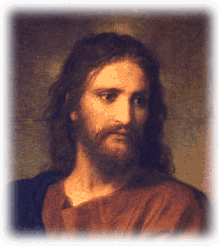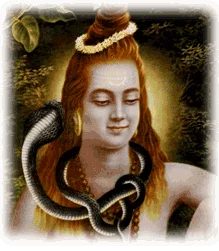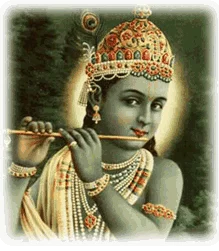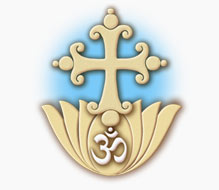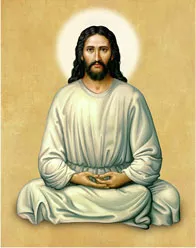Part 5 of Dwelling in the Mirror: A Study of Illusions Produced by Delusive Meditation and How Be Free from Them
 Now I would like to outline for you the most ancient and universal method of meditation: Soham Meditation.
Now I would like to outline for you the most ancient and universal method of meditation: Soham Meditation.
Some history
Yoga is an eternal science intended to reveal and manifest the Eternal. Although the identity of the Supreme Self (Paramatma) and the individual Self (jivatma) with Soham is indicated in the Isha Upanishad (16) and the Brihadaranyaka Upanishad (1.4.1) respectively, no one knows exactly when it was that the knowledge of Soham Yoga was revealed in the world, but the following we do know.
A young man was wandering in the mountains somewhere in India–most likely in the Western Himalayas. He had seen no one else for a very long time, but one day he heard the faint sound of a human voice. Following it, he saw from a distance some people seated together near a river. Slipping into the water, he began swimming toward them. All along the river on that side thick reeds were growing so he was not seen as he stealthily made his way closer.
Soon he began to understand what was being said. Fascinated by the speaker’s words he came as close as he dared and for a long time remained absorbed in the amazing things being spoken. For the science of yoga was being expounded by a master to his disciples. Then he heard the master say: “There is a ‘fish’ in the reeds over there, listening to everything I am saying. Why doesn’t he come out and join us?” He did as suggested and became a resident of the master’s ashram and learned both philosophy and Soham Yoga.
After diligent practice of meditation for quite some time, the master asked him to return to the plains and teach that yoga to whomever would listen. He was given a new name, Matsyendranath. (Matsyendra means Indra Among Fish and Nath means Master. Indra is king of the gods.) We have no knowledge of what the master’s name was. Matsyendranath and his disciples only referred to him as Adi Nath–Original/First Master. Some believe Adi Nath was Shiva himself manifested to teach yoga, or perhaps the primeval master Bhagavan Sanatkumara about whom the Brihadaranyaka Upanishad says: “To such a one who has his stains wiped away, Bhagavan Sanatkumara shows the further shore of darkness” (7.26.2).
Matsyendra wandered throughout India, teaching those who were awakened enough to desire and comprehend the yogic path. One day in his wanderings he came to a house where the owner’s wife gave him something eat and a request: that he would bless her to have a child. In response he blessed her and gave her some ashes from a sacred fire, telling her to swallow them. Then he left. The woman followed his instructions and soon conceived and gave birth to a male child. Several years later Matsyendra came there again and saw the little boy outside the house. He told him to bring his mother, and when she came he asked if she remembered him, which she did. Pointing to the boy, he said: “That is my child. I have come for him.” The woman agreed and Matsyendra left with the boy whom he named Gorakhsha, Protector/Guardian of Light.
Goraksha in time became Gorakshanath–usually called Gorakhnath), the greatest yogi in India’s recorded history. In every part of India there are stories told of his living in those areas. He also lived in Nepal, Tibet, Ladakh, and Bhutan. There are shrines and temples to him in all those countries, both Hindu and Buddhist. His major temple is in Gorakhpur, the birthplace of Paramhansa Yogananda whose younger brother, Sananda, was originally named Goraksha. Considering all the lore about him, Gorakhnath must have lived at least two or three hundred years, and there are many who claim that he has never left his body but is living right now in the Himalayas.
Gorakhnath had many disciples, a large number of them attaining enlightenment. They were the first members of the Nath Yogi Sampradaya, which in time numbered in its ranks the great sage Patanjali, founder of the Yoga Philosophy (Yoga Darshan) and author of the Yoga Sutras, and Jesus of Nazareth (Sri Ishanath). For many centuries the majority of monks in India were Nath Yogis, but in the nineteenth century there was a sharp decline in their numbers, which continues today. However there are several groups of “Nath Panthis” that follow the philosophy and yoga of Matsyendranath and Gorakhnath, and therefore are involved with Soham as the heart of their sadhana.
Soham
Soham means: I Am That. It is the natural vibration of the Self, which occurs spontaneously with each incoming and outgoing breath. By becoming aware of it on the conscious level by mentally repeating it in time with the breath (So when inhaling and Ham when exhaling), a yogi experiences the identity between his individual Self and the Supreme Self.
According to the Nath Yogis (see my book Soham Yoga) Soham has existed within the depths of God from eternity; and the same is true of every sentient being. Soham, then, will reveal our inner being. By meditating on Soham we discover our Self within which Soham has existed forever. The simple intonation of Soham in time with the breath will do everything in the unfolding of the yogi’s spiritual consciousness.
The practice is very simple, and the results very profound. Truly wondrous is the fact that Soham Yoga can go on all the time, not just during meditation, if we apply ourselves to it. The whole life can become a continuous stream of liberating sadhana. “By the mantra ‘Soham’ separate the jivatma from the Paramatma and locate the jivatma in the heart” (Devi Bhagavatam 11.8.15).
The important thing about Soham Yoga is that it really works. It only takes perseverance.
The two oldest Upanishads on Soham
The Isha and the Brihadaranyaka are the oldest of the Upanishads, giving us the earliest record of Soham that we know.
The Isha Upanishad concludes with four mantras that are to be recited by a dying person to ensure his ascension to the solar world upon leaving his body. (These mantras are also recited by those who attend the cremation of the body.) The sixteenth mantra says: “O Pushan, the sole seer, O Controller, O Sun, offspring of Prajapati, spread forth your rays and gather up your radiant light that I may behold you of loveliest form. I am that Purusha [Spirit-Self]: I AM SOHAM” (16). (The Sanskrit text is: Yo sav asau purushah; soham asmi.) At the core of every sentient being Soham exists as the Self–is the Self. Soham asmi literally means “I AM THAT I AM,” which is exactly what God told Moses was his Name (Exodus 3:14).
The Brihadaranyaka Upanishad (5.15.2) repeats the identical words. It earlier says: “In the beginning this (world) was only the Self [Atman], in the shape of a person. Looking around he saw nothing else than the Self. He first said, ‘I am Soham [Soham asmi]’” (1.4.1) Thus Soham is the “first speaking” of the Absolute Itself: the expression of the knowledge and knowing of the Self. Soham is the Name (Embodiment) of the Primeval Being, the Self of the Universe and the Self of our Selfs. Soham is the Consciousness of Brahman and of the Self of each one of us. We, too, are Soham.
The ancient yogis of India discovered that the root impulse of inhalation makes the subtle sound of So, and the root impulse of exhalation makes the subtle sound of Hum (written as Ham in Sanskrit). Since all creation is the thought or ideation of God, meaning is inherent in everything, including the breath: “That [So] I am [Ham].” In this way every living being is perpetually intoning Soham (Sohum) at the core of their being, saying: I AM THAT: the spirit-Self which is a divine part of the Divine Infinite.
No matter how many ages we wander in forgetfulness of our divine origin and nature, we are always affirming “I am That” without ceasing at each breath. But we have lost the awareness of that sacred thread of inmost knowledge and are now wandering without direction or discernment. But by mentally intoning Soham in time with the breath–So when inhaling and Ham when exhaling–we consciously take hold of the thread and begin moving in the right direction.
Repeating Soham in a constant flow with the breath turns the mind inward and produces spiritual awareness in an ever-increasing degree. So whenever we intone Soham in time with the breath, we align and link our consciousness with its origin: both our spirit and Divine Spirit.
For the repetition of Soham to produce its effect it must be pronounced correctly. Soham is pronounced like our English words So and Hum. The short a in Sanskrit is pronounced like the u in up or hunt, so we say “hum” even though we write it as “ham.”
It is most important to pronounce the O correctly. It should be pronounced like the long o in the Italian or common American manner–as in home and lone. In England, Canada, and parts of the American South, the long o is sometimes pronounced as a diphthong, like two vowels jammed together: either like “ay-oh” or “eh-oh.” This is not the correct manner of pronouncing the O, which should be a single, pure vowel sound.
The same is true of the U in ham (hum). As already pointed out, it is pronounced like the u in up or hunt–not like the u in truth or push, as is done in parts of Great Britain.
A mantra is most effective if it is mentally intoned–that is, mentally “sung”–on a single note. (The pitch does not matter–whatever is spontaneous and natural.) This makes the repetition stronger and of deeper effect, because intoning unifies the mind and naturally concentrates it.
The Practice of Soham Yoga Meditation
- Sit upright, comfortable and relaxed, with your hands on your knees or thighs or resting, one on the other, in your lap.
- Turn your eyes slightly downward and close them gently. This removes visual distractions and reduces your brain-wave activity by about seventy-five percent, thus helping to calm the mind. During meditation your eyes may move upward and downward naturally of their own accord. This is as it should be when it happens spontaneously. But start out with them turned slightly downward without any strain.
- Be aware of your breath naturally (automatically) flowing in and out. Your mouth should be closed so that all breathing is done through the nose. This also aids in quieting the mind. Though your mouth is closed, the jaw muscles should be relaxed so the upper and lower teeth are not clenched or touching one another, but parted. Breathe naturally, spontaneously. Your breathing should always be easeful and natural, not deliberate or artificial.
- Then in a very quiet and gentle manner begin mentally intoning Soham in time with your breathing. (Remember: Soham is pronounced like our English words So and Hum.)
Intone Soooooo, prolonging a single intonation throughout each inhalation, and Huuummm, prolonging a single intonation throughout each exhalation, “singing” the syllables on a single note.
There is no need to pull or push the mind. Let your relaxed attention sink into and get absorbed in the mental sound of your inner intonings of Soham.
Fit the intonations to the breath–not the breath to the intonations. If the breath is short, then the intonation should be short. If the breath is long, then the intonation should be long. It does not matter if the inhalations and exhalations are not of equal length. Whatever is natural and spontaneous is what is right.
Your intonation of Soooooo should begin when your inhalation begins, and Huuummm should begin when your exhalation begins. In this way your intonations should be virtually continuous:
SooooooHuuummmSooooooHuuummmSooooooHuuummm.
Do not torture yourself about this–basically continuous is good enough.
- For the rest of your meditation time keep on intoning Soham in time with your breath, calmly listening to the mental sound.
- In Soham meditation we do not deliberately concentrate on any particular point of the body such as the third eye, as we want the subtle energies of Soham to be free to manifest themselves as is best at the moment. However, as you meditate, you may become aware of one or more areas of your brain or body at different times. This is all right when such sensations come and go spontaneously, but keep centered on your intonations of Soham in time with your breath.
- In time your inner mental intonations of Soham may change to a more mellow or softer form, even to an inner whispering that is almost silent, but the syllables are always fully present and effective. Your intonations may even become silent, like a soundless mouthing of Soham or just the thought or movement of Soham, yet you will still be intoning Soham in your intention. And of this be sure: Soham never ceases. Never. You may find that your intonations of Soham move back and forth from more objective to more subtle and back to more objective. Just intone in the manner that is natural at the moment.
- In the same way you will find that your breath will also become more subtle and refined, and slow down. Sometimes the breath may not be perceived as movement of the lungs, but just as the subtle pranic energy movement which causes the physical breath. Your breath can even become so light that it seems as though you are not breathing at all, just thinking the breath (or almost so).
- Thoughts, impressions, memories, inner sensations, and suchlike may also arise during meditation. Be calmly aware of all these things in a detached and objective manner, but keep your attention centered in your intonations of Soham in time with your breath. Do not let your attention become centered on or caught up in any inner or outer phenomena. Be calmly aware of all these things in a detached and objective manner. They are part of the transforming work of Soham, and are perfectly all right, but keep your attention centered in your intonations of Soham in time with your breath. Even though something feels very right or good when it occurs, it should not be forced or hung on to. The sum and substance of it all is this: It is not the experience we are after, but the effect. Also, since we are all different, no one can say exactly what a person’s experiences in meditation are going to be like.
- If you find yourself getting restless, distracted, fuzzy, anxious or tense in any degree, just take a deep breath and let it out fully, feeling that you are releasing and breathing out all tensions, and continue as before.
- Remember: Soham Yoga meditation basically consists of four things: a) sitting with the eyes closed; b) being aware of our breath as it moves in and out, and c) mentally intoning Soham in time with the breath and d) listening to those mental intonations: all in a relaxed and easeful manner, without strain.
Breath and sound are the two major spiritual powers possessed by us, so they are combined for Soham Yoga practice. It is very natural to intone Soham in time with the breathing. The way is simple and easy. - At the end of your meditation time, keep on intoning Soham in time with your breath as you go about your various activities, listening to the inner mantric sound, just as in meditation. One of the cardinal virtues of Soham sadhana is its capacity to be practiced throughout the day. The Yoga Rasyanam in verse 303 says: “Before and after the regular [meditation] practice, the repetition of Soham should be continuously done [in time with the breath] while walking, sitting or even sleeping…. This leads to ultimate success.”
Can it be that simple and easy? Yes, because it goes directly to the root of our bondage which is a single–and therefore simple–thing: loss of awareness. Soham is the seed (bija) mantra of nirvanic consciousness. You take a seed, put it in the soil, water it and the sun does the rest. You plant the seed of Soham in your inner consciousness through japa and meditation and both your Self and the Supreme Self do the rest. By intentionally intoning So and Ham with the breath we are linking the conscious with superconscious mind, bringing the superconscious onto the conscious level and merging them until they become one. It is divinely simple!
Soham Yoga Sadhana in three sentences
The two supreme yogis of India’s history, Matsyendranath and Gorakhnath, and the Yoga Chudamani Upanishad have made three statements that are most important for the yogi, for they present the essence of Soham Sadhana.
- The inhalation comes in with the subtle sound of So, and the exhalation goes out with the subtle sound of Ham.
- There is no knowledge equal to this, nor has there ever been in the past or shall be in the future any knowledge equal to this.
- There is no japa equal to this, nor has there ever been in the past or shall be in the future any japa equal to this.
The implication is that the unequaled, and therefore supreme, knowledge and the unequaled and supreme yoga practice are the mental intonations of So throughout the inhalation and Ham throughout the exhalation. And therefore that intoning So and Ham in time with the breath is the totality of Soham Yoga practice.
Such gimmicks as thinking the breath is going up the spine with the intonation of So and down the spine with the intonation of Ham, or intoning Soham at the chakras, are not Soham Sadhana. Consequently, the Soham yogi’s attention should be only on the movement of his breath and his mental intonations of So and Ham in time with it.
These three statements of Matsyendranath, Gorakhnath and the Yoga Chudamani Upanishad also imply that the difference between Soham Yoga and other yogas is the difference between lightning and lightning bugs.
How is this? Because, as we have seen in the previous chapter, according to the Isha and Brihadaranyaka Upanishads the fundamental nature of both the Supreme Self (Ishwara) and the Individual Self (Jiva) of each one of us, is Soham. Soham Sadhana takes us directly and immediately into the consciousness of the Self and the Supreme Self, simultaneously. Other yoga practices do not do this, but go about it in a roundabout manner, taking many years (if not decades) before even beginning to do what Soham Sadhana does from the very first.
In Soham Yoga only the sufficient time to experience the full range of Self-experience and become permanently established in that experience is necessary for the Soham yogi to become liberated. As soon as he truly knows: “I am Soham,” the Great Work is complete. For Ishwarapranidhana not only means offering the life to God, it also literally means offering the breath (prana) to God. This is done by intoning So during inhalation and Ham during exhalation, both in meditation and the rest of the day and night. In this way Soham Bhava, God-consciousness, is attained.
What can you expect?
Yoga and its practice is a science and the yogi is the laboratory in which that science is applied and tested. At first the aspirant takes the word of a book, a teacher or other aspirants that a yoga method is worthwhile, but eventually it is his personal experience alone that should determine his evaluation of any yoga practice. Because each person is unique in his makeup there can be a tremendous difference in each one’s experience of yoga. Nevertheless, there are certain principles which can be stated.
If a yogi is especially sensitive or has practiced the method in a previous life, he may get obviously beneficial results right away. Yet for many people it takes a while for a practice to take hold and produce a steadily perceptible effect. One yogi I knew experienced satisfactory effects immediately. Then to his puzzlement for some days it seemed that absolutely nothing was happening, that his meditation was a blank. But he had the deep conviction (no doubt from a past life as a yogi) that Soham sadhana was the right and true way for him. So he kept on meditating for hours at a time. Then one morning during the final hour of meditation results began coming in the form of experiences that he had not had before. All doubt was dispelled, and he knew he was on the right track. From then onward everything was satisfactory, though there were alternating periods of active experiences and simple quiet observation of inner rest.
Experiences, as I say, can be different for everyone, but certainly peace and refinement of consciousness can be expected. Many things will occur that simply cannot be described because ordinary human language has no words for them. The real test is the yogi’s state of mind outside meditation. This he should watch carefully. And he must make sure that he is always practicing correctly. Fortunately, Soham sadhana is simple and easy to do.
Warning: Do Not Interfere!
We are used to directing and controlling as much of our life as possible. But what applies to the external life as wisdom is not necessarily so in the internal life of meditation. The very simple twelve points given previously when followed exactly in a relaxed and calm manner will produce the inner environment in which Soham can do its divine work of revealing itself as the consciousness that is the yogi’s true Self. If there is any interference in the form of trying to change something or direct the meditation or experience in any way, the process is interrupted and will produce no results. Naturally, since the practice is so incredibly simple and we have read all kinds of propaganda about “powerful” yogas and the chills and thrills they produce and the “profound insights” and even visions of higher worlds, etc. and etc. that supposedly result from them, we wonder if there surely isn’t “more than this to it” and consider trying out such gimmicks as intoning Soham at the chakras, integrating it with some artificial form of pranayama, concentrating on the spine while visualizing/imagining currents moving up and down the spine, and other “enhancements” that may entertain but will only be obstacles to success in Soham sadhana.
The truth is that Soham intoned in time with the breath immediately begins producing a tremendous number of yogic kriyas, but kriyas that are so subtle and natural that they are usually not perceived. It takes real refinement of the mental energies to experience much of what Soham effects in the entire being of the yogi. I have been astonished at how profound the effects of Soham sadhana are, and some of my experiences have been really incredible, but I have had decades of yogic practice behind me to enable me to experience and understand the workings of Soham. I am not describing any of these experiences lest when you encounter them yourself you wonder if your experience is only autosuggestion based on my description.
Be wise and just breathe and intone Soham in time with it with eyes closed during mediation and open during the rest of the day’s activity. Nothing else, but just being aware of that process and listening to the inner intonations of Soham is the secret and the assurance of success. And that is all. Soham must not be interfered with–it really cannot be, so any attempt will interrupt and spoil the practice and drag you back on the path of samsara, however “yogic” it may seem to you.
Simplicity of practice
The simpler and more easeful the yoga practice, the more deeply effective it is. This is a universal principle in the realm of inner development and experience. How is this? In the inner world of meditation things are often just the opposite to the way they are in the outer world. Whereas in the outer world a strong aggressive force is most effective in producing a change, in the inner world it is subtle, almost minimal force or movement that is most effectual–even supremely powerful. Those familiar with homeopathic medicine will understand the concept that the more subtle an element is, the more potentially effective it is. In meditation and japa the lightest touch is usually the most effective. This being so, the simple subtle intonations of Soham are the strongest and most effective form of mantric invocation.
An incident that took place during one of the crusades illustrates this. At a meeting between the leaders of the European forces and Saladin, commander of the Arab armies, one of the Europeans tried to impress and intimidate Saladin by having one of his soldiers cleave a heavy wooden chair in half with a single downstroke of his broadsword. In response, Saladin ordered someone to toss a silk scarf as light and delicate as a spider’s web into the air. As it descended, he simply held his scimitar beneath it with the sharp edge upward. When the scarf touched the edge, it sheared in half and fell on either side of the blade without even a whisper as he held it completely still. This is the power of the subtle and simple practice of Soham Yoga meditation.
Subtlety of practice
Soham sadhana is extraordinarily powerful, yet until we become attuned to it by some time of practice it may seem very mild, just a kind of yogic sitting-up exercise. But it is a mighty tool of yoga alchemy. The secret of its power and effectiveness is its subtlety–the very thing that may cause it to be disregarded and not recognized for its intense value, for it is the subtle energies that are able to work lasting changes in our awareness. The more evolved consciousness or energy becomes, the more refined and subtle it becomes–truly spiritual.
It is the very subtle energies that are able to work lasting changes in our awareness. The more evolved consciousness or energy becomes, the more refined and subtle it becomes. Thus it is the highest level of spiritual powers alone that are able to effect our ascent in consciousness.
Tension of any kind interferes with these energies. It is important, then, to keep in mind that often when things seem stuck in meditation and not moving as they should, or when the mind does not calm down, it is often because we are not relaxed sufficiently and are not allowing our inner intonations of Soham to become as subtle as they should be. For the subtler the intonations, the more effective and on target they are.
Even so, I do not mean to give you the impression that your inner intonations of Soham should become feeble or weak in the sense of becoming tenuous–only barely within your mental grasp, and liable to slip away and leave you blank. Not at all. The inner sound of the intonations may become subtler and subtler, but they do not at all become weaker–only gentler and more profound and therefore more effective.
An exception
In point 6 of the Soham Meditation instructions I said that “we do not deliberately concentrate on any particular point of the body such as the third eye, as we want the subtle energies of Soham to be free to manifest themselves as is best at the moment.” There is an exception to that. On occasion, such as at the very beginning of meditation or when during the rest of the day you find your attention drifting from the breath and Soham, it can be helpful to make yourself very gently (lest you give yourself a headache from tension) aware of your entire brain (Sahasrara) area, feeling that the breath and Soham intonations are taking place there.
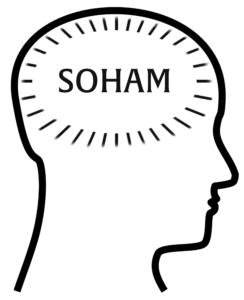
A short time of this awareness (which can arise spontaneously as well) is sufficient, because correct practice will result in Sahasrara awareness naturally.
And now…
And now “the way ye know” (John 14:4). However, it is always good to know as much as possible about the meaning of meditation practice and the reasons behind it as well as the purpose. Therefore I urge you to obtain and study the book Soham Yoga, the Yoga of the Self, which will give you a great deal of practical information on the various aspects of Soham Meditation, especially the why and wherefore of this sacred practice and the ways to apply and increase the effectiveness of your practice.
Read the Appendix of Dwelling in the Mirror: Abnormal States and Spiritual Illusions

